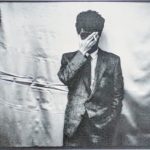
Simply impressive. What else is there to say about Tsugutoshi Goto’s City Trickles: 街の雫? Most double-LP’s suffer under the weight of their own reach, but the best one’s justify their length due to the sheer scope of that maker’s vision. And boy does Tsugutoshi Goto have one here. From neck-snapping electro, out-there fusion to impressive New Age and Ambient Pop, it seems Tsugutoshi left no stone unturned to make this, his statement piece.

Quietly reinforcing the works of others through his phenomenal bass playing, on his own albums he coursed further, trying to scope out new territory. Kenji, originally began his musical career in Tokyo performing with rock bands like the Sadistic Mika Band or pioneering J-Pop idols like Kenji Sawada, City Pop heavies Bread & Butter and folkies like Hosono’s Tin Pan Alley would also come to ask for his services (either on stage or in the studio). As a session musician there were few as peerless as for one reason: Tsugutoshi’s masterful, fretless bass playing. However, when it came time to lay down his own ideas, Goto did things differently.

Originally, he proceeded carefully, creating albums that easily slotted into Jazz or funk genres. Needlessly flashy and dated, Tsugutoshi was working under expected expectations. Things would change in the ‘80s. Signed by Sony to their fledgling Fitzbeat label, Tsugutoshi was given the lee-way to actually go for a more personal vision. With others he had already written more structured songs and actual Pop music, for his own releases he got to flesh out the influences of Brian Eno and post-disco floating around that time.
Breath, his debut with Fitzbeat, is a masterpiece of instrumental Walearic sketches showing his special talent with intricate bass lines and rhythmic dance music. Inner Suggestions, found the contemporary techno-pop from the likes of Ippu Do and YMO slicing into his own highly danceable form of Pop music. Here’s where you can hear the influences of New Order, the Alan Parsons Project (!), and Minneapolis Funk suture themselves in. With each album Tsugutoshi’s prowess as both producer and composer clearly growing, the technological advances of the time (sampling and computer based) started to allow him to grow even bolder with his music. Harder-nosed than most techno-kayo, you could count on his work at Fitzbeat to sound boomin’ on a car stereo but also play as some kind of “wonderland” headphone music.
Ridding himself of the last vestiges of his jazz and rock beginnings, on his third album, City Trickles, Tsugutoshi swung for the fences. Dividing this double album into two movements: Outer and Inner, Tsugutoshi aimed for one side to show his truly experimental side and the other to be immediately accessible and personal. Keeping nearly the same crew he worked with previously — Hideo Yamaki, Hideki Matsutake, Kenji Omura, and Jun Aoyama — and adding others (Ryomei Shirai from Moonriders, J-Reggae beast keyboardist Haruo Togashi, Paradigm Shift’s Satoshi Nakamura, and vocalist Etsuko Yamakawa) to complement a new direction.

It’s hard to pinpoint a sound for the all-instrumental “Outer” side. The opening track, “The Breaking Point”, approximates Rockit via glitched-out psychedelic techno. “Broken Sleep” imagines Cameo’s music as vehicle for some EBM juggernaut, with Hideki lending a particularly chaotic arrangement some controlled groove. “Passing Visions”, a highlight of this side, imagines the midway point between Japanese New Age and the floating Walearic music Tsugutoshi placed piecemeal on his other, earlier albums. A fascinating track, it allows Kenji to approximate the floating, violin tone of Robert Fripp and Tsugutoshi and Hideo Yamaki to treat their drum and bass interplay as bludgeoning judge, jury, and executioner.

The flip side of this “Outer” movement then throws you head first into songs that wouldn’t sound out of place on a good ‘80s King Crimson record. Simply put, songs like “Conundrum”, “Grey Scape”, and “Urgent” are knotty, wiry, heady tracks that ooze as much technique as they do firey darkscapes. The best, in my opinion, is still left for the “Inner” movement.
On the other LP, Tsugutoshi aimed for the charts in the most unrelenting way ever. Whether siphoning Etsuko Yamakawa’s vocals through harmonizers or vocoders, every ounce of production in this side sounds more of our time than that time. Ambient Pop burners like “First Solitude” imagine the dancefloor as a silent dance partner. Weirdly tripped out synth lines vaporize and drum machines gain melodic lines, Tsugutoshi’s bass lines trump out dirty space disco that lures more than propulse. The Fairlight II funk of “Silent Partner” once again conjures a bunch of “what ifs”. What if Prince actually cared to make his jazz experiments as perfect as his pop exploits. Tsugutoshi’s swooping Minneapolis Funk bass, via Yokohama tires, swallows that wicked fusion and pushes out some kind of Ambient Funk that’s truly his, see-sawing between joy and wanton retrospection, in that way.
I can’t speak highly enough for the rest of this album. You might get flashes of the best of this decade, done in a way that’s even more forward thinking. “Closing Scene” would have been a song that could have been a hit if it was released outside of Japan. “Concentration: Snow Joke” goes for reggae and comes out with a multi-layered plunderphonic take on tropical jazz. The introduction of the snakey vocals by Etsuko then transform this song into a gorgeous, all-in, Trevor Horn-like take on Caribbean Pop music. Ending on yet another Ambient Pop mystery, City Trickles uses “Night Landing” as a swooping cap to festoon an album that can’t make up its mind whether its an experimental journey or a burning Pop record, and decides its both — of course, to its own benefit. If it wouldn’t, we wouldn’t still be here, trying to work out it’s magic.
